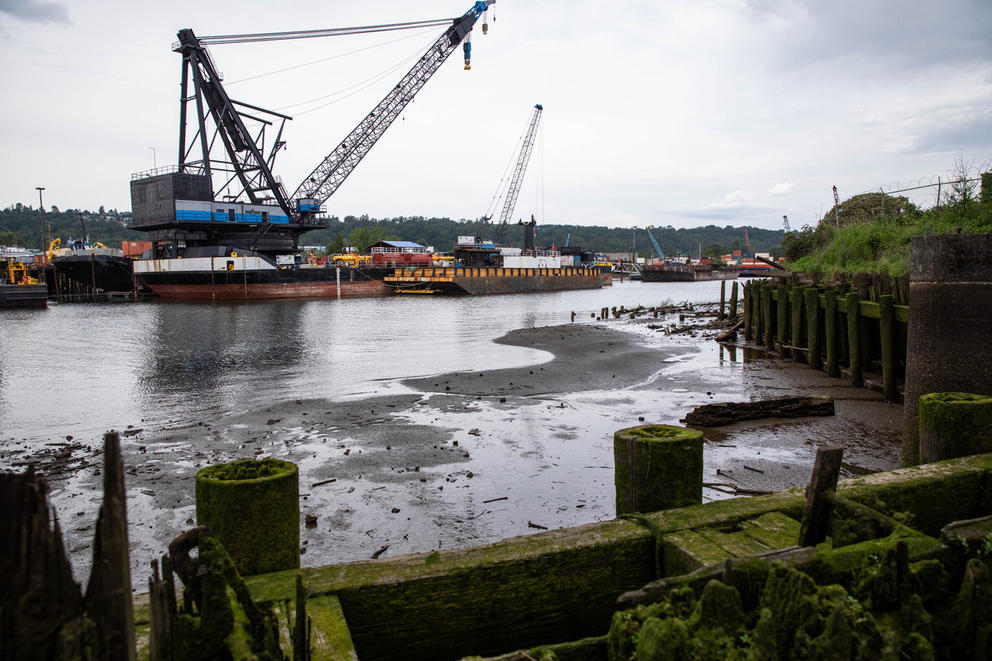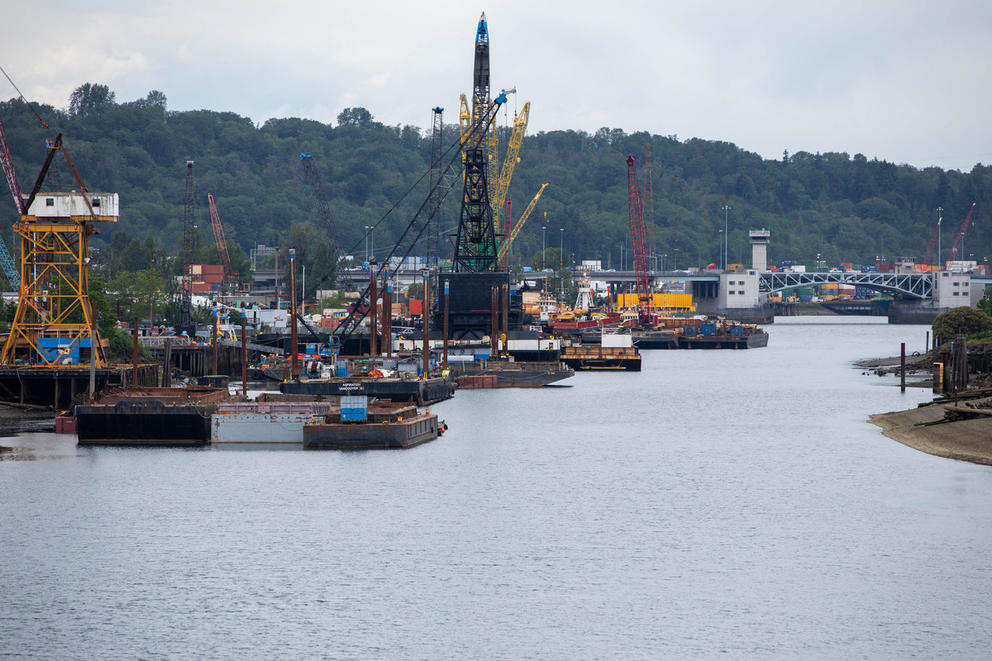The delay stems from the conflicting goals of two influential interest groups.
On one side are the Port of Seattle, maritime industrial business owners, the International Longshore and Warehouse Union, Ballard fisheries, the railroads and truckers. They want better protections to keep non-industrial uses out of industrial zones.
On the other are real estate developers, non-industrial businesses, the building trades unions, the stadiums management group, affordable-housing advocates and others. They want to expand into valuable underdeveloped industrial land, especially near the water.
The city is now poised to break the loggerhead.
Doing so required a multiyear series of meetings led by an outside mediator. More than 60 stakeholders came together and eventually reached 85% agreement on a package of policies that would close loopholes to better protect industrial-zoned lands for actual industrial work while allowing more housing and other uses in the buffers between industrial and traditional commercial land, among other goals.
That package of legislation is now working its way through the Seattle City Council, with a final vote expected this summer. But getting to that final vote will depend on the outcome of an 11th-hour debate over whether to develop housing, hotels and commercial space in SoDo near the stadiums.
The push to include the SoDo “Makers District” in the final package (or put it back in the package, depending on whom you ask) threatens to upend the entire delicate compromise.
“If you want to know why it’s been so many years and we haven’t made progress, it is because of the disagreement about what happens in the stadium district,” said City Councilmember Dan Strauss, who chairs the Land Use Committee. “We can’t hold up these other benefits while we wait for compromise [in SoDo].”
What’s changing on industrial lands
Seattle’s industrial lands account for about 12% of the city’s total land area, mostly in Ballard/Interbay and the Greater Duwamish industrial area, which includes the Port of Seattle, SoDo, Georgetown and South Park along the Duwamish River.
The city’s industrial and maritime sectors provide about 100,000 jobs, or 15% of Seattle’s total employment. Many of those jobs are unionized and provide living wages, and about two-thirds don’t require a four-year college degree.
The core of the city’s industrial strategy is to create three new industrial zones, meant to tighten restrictions on use in some places while loosening the rules in others.
The new Maritime, Manufacturing and Logistics (MML) zone would draw that harder line around existing lands that industrial stakeholders want. The MML zone would apply to existing “industrial areas with a concentration of core industrial and maritime uses including manufacturing, warehousing, shipping, and logistics activities and is well served with truck, rail, and maritime or freight infrastructure.”
The new zone would place size restrictions on non-industrial uses, like grocery and hardware stores, animal shelters and office space, to discourage their construction. The package outright bans construction of mini-self-storage facilities in industrial zones.
“We know once it’s zoned away from industrial, you never get it back. Nobody ever downzones,” said Port of Seattle Commissioner Ryan Calkins, referring to the need to protect existing industrial zones.
The new Industry and Innovation zone would encourage denser industrial development, especially near existing and future light-rail stations within Seattle’s industrial lands. It is meant to spur construction of multistory buildings for light-industrial manufacturing, research and development, and other industrial-adjacent businesses that don’t require the same quantity of space as traditional industry.
The Industry and Innovation zone would also allow non-industrial office space as a developer bonus. A developer could build the upper floors of a building for non-industrial use only if the lower floors were dedicated to an approved industrial use.
The third new zone is called Urban Industrial and is meant to improve the buffer zones between MML zones and residential and commercial districts. The Urban Industrial zone would permit things like breweries and taprooms, art studios, restaurants, retail and offices, but would reduce the maximum size of those buildings. The new zone comes with more stringent requirements for pedestrian improvements such as sidewalks, curb cuts, lighting and street trees.
Urban Industrial zones would also permit construction of some housing meant to be affordable to industrial workers. The housing must be affordable to someone earning 60%-90% of the area median income; additional regulations include being built with sound dampening. In total, the city expects about 880 units of housing to be built in Urban Industrial zones.
The rezones are meant to assure existing industrial business owners and would-be investors that Seattle’s industrial lands will remain viable. The plan is spelled out in more detail in the “Industrial and Maritime Strategy.”
“There are other pressures on the Port … But this is making sure that if you’re going to make millions of dollars of investment in an system, that the system is going to be allowed to operate and not be infringed upon by residential and other uses,” said Jordan Royer, Pacific Merchant Shipping Association vice president (and former chair of Crosscut’s Board of Directors).
In addition to the new zones, the package of legislation would redraw the boundaries of industrial zones in Ballard, Georgetown, South Park and Judkins Park to remove some existing industrial land in areas that are already mostly residential and commercial. Those areas will be rezoned as Neighborhood Commercial, which allows both residential and commercial construction and is estimated to result in the building of about 2,000 new homes over the next 20 years.
All told, the policies in the Industrial and Maritime Strategy are expected to result in the creation of 35,500 new jobs within the affected areas — 12,000 more jobs than are projected to be created without the changes. Of those projected new jobs, 16,350 would be industrial employment.
Fraught politics could upend it all
Whether any of the package can move forward relies in large part on how a fight shakes out over the so-called Makers District in SoDo. The idea is to build housing, hotels and commercial space targeted at “makers” such as artisans, artists and beer brewers on land adjacent to the stadiums.
Supporters say it’s a win/win/win that would construct about 900 units of much-needed housing and bolster pedestrian activity between games and events, providing support for businesses in surrounding neighborhoods and improving safety with more eyes on the street. The list of proponents includes the Washington State Public Stadium Authority, the Washington State Ballpark Public Facilities District, the Housing Development Consortium, the Seattle Building and Construction Trades Council, the International Brotherhood of Electrical Workers, the hotel and hospitality union Unite Here and others.
The Port, the International Longshore and Warehouse Union, Sailors’ Union of the Pacific and other maritime industrial groups are fighting the idea. They are concerned that more development will bring additional traffic that will hurt freight mobility in and out of the Port, create additional risks of dangerous interactions between pedestrians and trucks and spur complaints from residents about noise and light from Port activity. There’s also a belief that allowing such development in SoDo could open the door to similar development on other industrial lands.
The city’s environmental impact analysis of the entire package looked at the idea of housing in the stadium district and concluded that “Some limited amount of housing would be compatible with the surrounding use pattern and would not cause additional adverse impacts on nearby industrial activities outside of the [Stadium District] if carefully implemented.”
Nearly a decade ago, hedge-fund manager Chris Hansen led an effort that included acquiring land to build a third stadium in SoDo to house a NHL team and hopefully bring an NBA franchise back to Seattle. That idea was quashed in the face of similar opposition from the Port and maritime industrial stakeholders.
Today’s fight over the Makers District is not only reminiscent of the stadium fight, it is an extension of it. According to Monty Anderson, executive secretary of the Seattle Building and Construction Trades Council, the Makers District would be built on land Hansen and his Sonics Investment Group acquired for the stadium project.
The would-be developers have committed to an agreement with the Building Trades that would ensure high wages and training opportunities.
“It’s a good project, it’s lots of work [for the construction industry], and here’s the big kicker: It doesn’t cost the taxpayers anything,” said Anderson. “It’s actually private money building affordable housing. We felt it was very important to have that kind of recipe.”
For Nicole Grant, political director of the International Brotherhood of Electrical Workers Local 46, that mix of benefits makes the challenging political fight worth it.
“The Port’s value to Seattle is very high. There would not be any light decision from our organization to just casually threaten that industry for something that doesn’t matter,” said Grant. “But to us, this meets the threshold. It has been studied and determined to be feasible and to not threaten industrial lands. It’s worth it. It’s not frivolous.”
From the Port’s perspective, any new development would negatively impact freight, since the development would be constructed near the intersection of Interstates 90 and 5 and near key railyards. In addition, Port Commissioner Calkins said the choice between housing or no housing on remaining industrial land is a false dichotomy when so much of Seattle’s existing residential neighborhoods are filled with low-density single-family housing.
Calkins said the Port lobbied in support of the missing-middle housing bill in Olympia to allow quad- and six-plexes where currently single-family homes are the only thing permitted — a first for the Port, to his knowledge.
Because the Makers District idea was not part of the consensus package that the mediated stakeholder group voted on, Strauss said its inclusion in the City Council’s legislation would lead to the Port and others pulling support, upending the entire effort.
“We could make the choice right now of putting the 1% of issues in the Stadium District above the 99% of the rest of the package, or move ahead and make these benefits to the greater city happen,” said Strauss.
Instead, Strauss wants to table the issue and come back to it after the rest of the package has been adopted by the City Council.
Revisiting the Makers Idea after the package has been passed, however, would likely require a similarly arduous process of mediated negotiations between groups.





